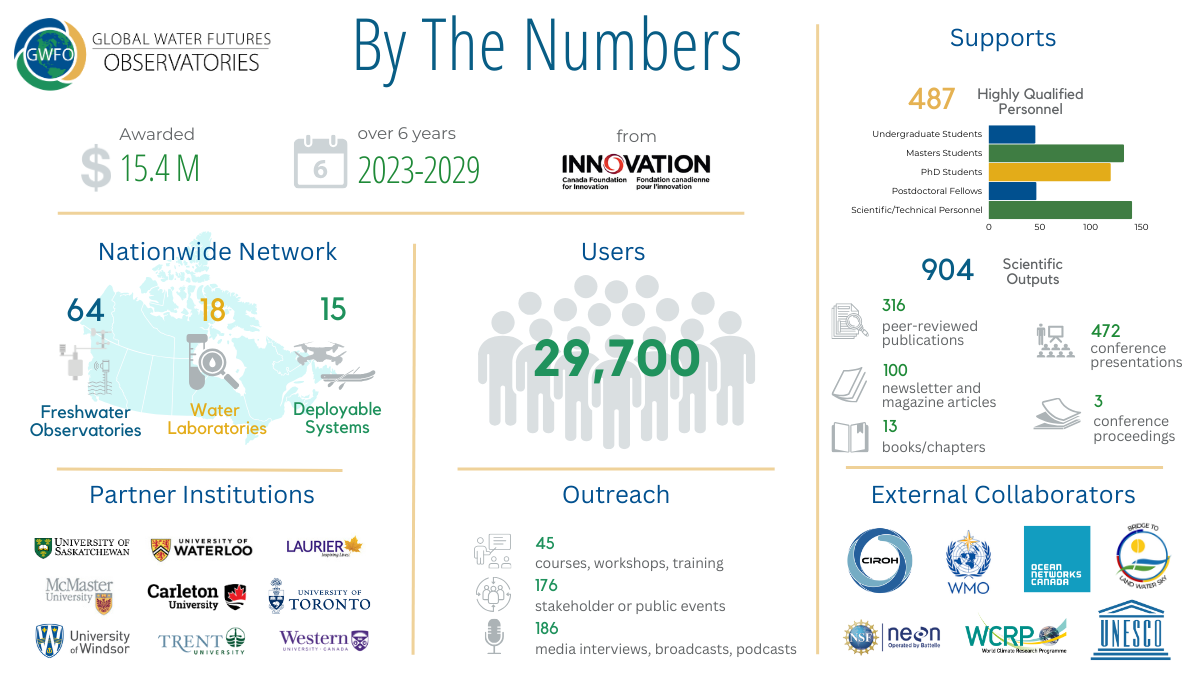About GWFO
Overview
Global Water Futures Observatories (GWFO)
GWFO is Canada's premier national freshwater research facility, funded in part through the Canada Foundation for Innovation (CFI) and its Major Science Initiatives (MSI) from 2023–2029. GWFO supports critical water research to safeguard Canadian water resources in an era of rapid change. It operates 64 instrumented water observation sites in lakes, rivers, wetlands, glaciers, and drainage basins across Canada; 15 deployable measurement systems for specialized field data acquisition; and 18 state-of-the-art water laboratories at the partner universities for detailed water quality, biological, and other analyses. The geographical scope of GWFO covers four major transboundary (interprovincial and territorial, international) river basins, including the Yukon, Mackenzie, Saskatchewan–Nelson, and Great Lakes–St. Lawrence. GWFO is led by the University of Saskatchewan (USask) and is a partnership amongst USask, the University of Waterloo, McMaster University, Wilfrid Laurier University, the University of Windsor, Trent University, Carleton University, the University of Western Ontario, and the University of Toronto.
GWFO provides open access to its freshwater data. It provides this urgently needed data to support flood, drought, and water quality solutions that help safeguard Canadian water resources. GWFO partners with Indigenous communities and practitioners and policy-makers in government, industry, conservation, and other sectors to develop capabilities, reduce risk, and better manage water as we face unprecedented challenges from global warming and rapid environmental change.

Our Vision
To operate a national freshwater research facility that supports critical water research to safeguard Canadian water resources in an era of rapid change. GWFO consists of instrumented water observing sites, supported by deployable observing systems and major laboratories, which provides open access water data and the necessary infrastructure to collect supplementary data. This data informs the development and testing of water prediction models, monitors changes in water sources, underpins diagnosis of risks to water security and helps design solutions to ensure the long-term sustainability of Canadian water resources.
Principles of Operation:
- provide unique water data of interest to characterizing and monitoring the water conditions of Canadian river basins
- contribute to a critical baseline of water data to the benefit of multiple users
- support the data collection from, and analysis of water from a pan-Canadian network of instrumented water observing sites
- adhere to the principles of open access
History
GWFO sustains a legacy of freshwater observations and scientific infrastructure investment in Canada that goes back many decades. A number of the sites are long-term water observatories that have records going back 50+ years, making them invaluable for the monitoring and detection of hydrological and water quality changes, and for developing in-depth understanding of the physical and biological responses to climate change and human pressures. Other sites have been established more recently, but contribute important and targeted observations in strategic and poorly monitored or poorly understood regions.
GWFO was realised through the investment in freshwater observing instrumentation and laboratories by the Canada Foundation for Innovation (CFI), the Natural Sciences and Engineering Research Council (NSERC), and federal and provincial/territorial government investments. Investment from CFI through its Major Science Initiative (MSI) has established GWFO as a national research facility with integrated management of Canada-wide field observations, operations and analysis, data management, and outreach and knowledge mobilization with data users.
